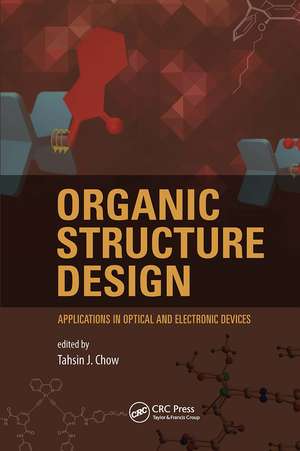Organic Structures Design: Applications in Optical and Electronic Devices
Editat de Tahsin J. Chowen Limba Engleză Hardback – dec 2014
Preț: 660.51 lei
Preț vechi: 881.21 lei
-25% Nou
Puncte Express: 991
Preț estimativ în valută:
126.40€ • 137.26$ • 106.18£
126.40€ • 137.26$ • 106.18£
Comandă specială
Livrare economică 02-16 aprilie
Doresc să fiu notificat când acest titlu va fi disponibil:
Se trimite...
Preluare comenzi: 021 569.72.76
Specificații
ISBN-13: 9789814463348
ISBN-10: 9814463345
Pagini: 538
Ilustrații: 230 black & white illustrations, 16 colour illustrations
Dimensiuni: 152 x 229 x 36 mm
Greutate: 0.88 kg
Ediția:1
Editura: Jenny Stanford Publishing
Colecția Jenny Stanford Publishing
ISBN-10: 9814463345
Pagini: 538
Ilustrații: 230 black & white illustrations, 16 colour illustrations
Dimensiuni: 152 x 229 x 36 mm
Greutate: 0.88 kg
Ediția:1
Editura: Jenny Stanford Publishing
Colecția Jenny Stanford Publishing
Public țintă
Academic and PostgraduateRecenzii
"Presenting an overview of the syntheses and properties of organic molecules and their applications in optical and electronic devices, this book covers aspects concerning theoretical modeling for electron transfer, solution-processed micro- and nanomaterials, donor–acceptor cyclophanes, molecular motors, organogels, polyazaacenes, fluorogenic sensors based on calix[4]arenes, and organic light-emitting diodes. The publication of this book is timely because these topics have become very popular nowadays. The book is definitely an excellent reference for scientists working in these areas."
—Prof. Henry N. C. Wong, The Chinese University of Hong Kong, Hong Kong
—Prof. Henry N. C. Wong, The Chinese University of Hong Kong, Hong Kong
Notă biografică
Tahsin J. Chow is a research fellow in the Institute of Chemistry, Academia Sinica, Taiwan, and an adjunct professor in the Department of Chemistry at National Taiwan University. He obtained his BS from National Taiwan University in 1972 and a PhD from the University of Cincinnati, USA, in 1980. Prof. Chow has been an Alexander von Humboldt scholar in 1988–1989 and became a fellow of the Federation of Asian Chemical Societies in 2005. His research interests are in the field of organic and physical organic chemistry, and in recent years, he has especially focused on organic electronic materials.
Cuprins
Preface, 1. Theoretical Modeling for Electron Transfer in Organic Materials, 2. Organic Structure Design and Applications in Solution-Processed Organic Micro- and Nanomaterials, 3. Synthesis, Structure, and Electronic and Photophysical Properties of Donor–Acceptor Cyclophanes, 4. Light- and Electricity-Gated Internal Rotation of Molecular Rotors: Toward Artificial Molecular Machines, 5. Supramolecular Assemblies of Organogels Featuring p-Conjugated Framework with Long-Chain Dicarboxamides, 6. Quinoxaline-Based Polycyclic Molecules Having Defined Shapes: From Orthocyclophanes to Polyazaacenes, 7. Fluorogenic Sensors of Heavy Metal Ions Based on Calix[4]arenes Functionalized by 1,3-Dipolar Cycloaddition Reactions, 8. Electron Transport Materials in Organic Light-Emitting Diodes: Design Considerations and Structural Diversity, 9. Electrochemical Deposition of Carbazole and Triarylamine Derivatives and Their Polymeric Optoelectronic Applications, 10. Solution-Processed Acenes and Their Applications on Field-Effect Transistor, 11. New Synthetic Route to Acenes
Descriere
The application of organic materials on optical and electronic devices is a fast-growing research area, combining the classical electronic properties of metals and the advantageous properties of organic materials. The functional applications include light-emitting diodes, organic solar cells, field-effect transistors, artificial machines, chemical sensors, and many others. This book provides a review on several topics in this area. The contents are focused mainly on the design and synthesis of organic functional molecules, and also include related topics such as model study on electron transfer phenomena and fabrication technologies of organic nanostructures.
